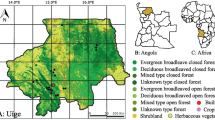Abstract
This article examines current net hunting practice by BaAka Pygmies of central Africa. In terms of time allocation, net hunting remains the single most important activity for the BaAka, But net hunting is only one in a range of subsistence and economic activities among which individuals switch on a daily basis. Returns from net hunting are roughly equivalent to those from competing activities. Several factors encourage the decline of net hunting and its replacement with snare hunting: enforcement of park regulations, higher individual returns to snare hunting, and greater involvement in formal employment and agriculture. However, net hunting has not been abandoned completely for several reasons: the local market demand for bushmeat is growing, numerous forest products besides meat are collected on net hunts, and economic alternatives remain irregular and unreliable.
Similar content being viewed by others
REFERENCES
Abruzzi, W. S. (1979). Population pressure and subsistence strategies among the Mbuti pygmies. Human Ecology 7(2): 183–189.
Abruzzi, W. S. (1980). Flux among the Mbuti Pygmies of the Ituri forest: An ecological interpretation. In Ross, E. B. (ed.), Beyond the Myths of Culture: Essays in Cultural Materialism. Academic Press, New York, pp. 3–31.
Arom, S., and Thomas, J. M. C. (1974). Les Mimbo, génies du piégeage et le monde surnaturel des Ngbaka-Ma'bo (République Centrafricaine). SELAF, Paris.
Bahuchet, S. (1972). Etude écologique d'un campement de Pygmées BaBinga (Région de la Lobaye, République Centrafricaine). Journal d'Agriculture Tropicale et de Botanique Appliquée 19(12): 509–559.
Bahuchet, S. (1985). Les pygmées Aka et la forêt Centrafricaine: Ethnologie écologique. SELAF, Paris.
Bahuchet, S. (1991). Les Pygmées d'aujourd'hui en Afrique centrale. Journal des Africanistes 61(1): 5–35.
Bahuchet, S., and Guillaume, H. (1982). Aka-farmer relations in the northwest Congo basin. In Leacock, E., and Lee, R. (eds.), Politics and History in Band Societies. Cambridge University, Cambridge, pp. 189–211.
Bailey, R. C., and Peacock, N. R. (1988). Efe Pygmies of northeast Zaïre: Subsistence strategies in the Ituri forest. In de Garine, I., and Harrison, G. A. (eds.), Coping with Uncertainty in Food Supply. Clarendon, Oxford, pp. 88–117.
Berry, J. W., van de Koppel, J. M. H., Sénéchal, C., Annis, R. C., Bahuchet, S., Cavalli-Sforza, L. L., and Witkin, H. A. (1986). On the Edge of the Forest: Cultural Adaptation and Cognitive Development in Central Africa. Swets North America, Berwyn.
Demesse, L. (1978). Changements techno-économiques et sociaux chez les Pygmées BaBinga (nord Congo et sud Centrafrique). SELAF, Paris.
Dwyer, P. D. (1983). Etolo hunting performance and energetics. Human Ecology 11(2): 145–174.
Dwyer, P. D. (1985). The contribution of non-domesticated animals to the diet of Etolo, Southern Highlands Province, Papua New Guinea. Ecology of Food and Nutrition 17(2): 101–115.
Dwyer, P. D., and Minnegal, M. (1991). Hunting in lowland, tropical rain forest: Toward a model of nonagricultural subsistence. Human Ecology 19(2): 187–212.
Harako, R. (1976). The Mbuti as hunters: A study of ecological anthropology of the Mbuti Pygmies. Kyoto University African Studies 10: 37–99.
Hart, J. A. (1978). From subsistence to market: A case study of the Mbuti net hunters. Human Ecology 6(3): 325–353.
Hewlett, B. (1977). Notes on the Mbuti and Aka Pygmies of Central Africa. MA thesis, California State University, Chico, CA.
Ichikawa, M. (1981). Ecological and sociological importance of honey to the Mbuti net hunters, eastern Zaïre. African Study Monographs 1: 55–68.
Ichikawa, M. (1983). An examination of the hunting-dependent life of the Mbuti Pygmies, eastern Zaïre. African Study Monographs 4: 55–76.
Martin, F. W., and Ruberte, R. M. (1978). Survival and Subsistence in the Tropics. Antillian College, Mayaguez, Puerto Rico.
Martin, G. H. G. (1985). Carcass composition and palatability of some wild animals commonly used as food. World Animal Review (53): 40–44.
Noss, A. J. (1995). Duikers, Cables and Nets: A Cultural Ecology of Hunting in a Central African Forest. PhD dissertation, University of Florida, Gainesville.
Noss, A. J. The impacts of cable snare hunting on wildlife populations in the forests of the Central African Republic. Conservation Biology (in press b).
Noss, A. J. Cable snares and nets in the Central African Republic. In Robinson, J. G., and Bennett, E. (eds.), Sustainability of Hunting in Tropical Forests (in press a).
Noss, A. J. The Aka of the Central African Republic. In Weber, W., Vedder, A., Simons Morland, H., White, L., and Hart, T. (eds.), African Rain Forest Ecology and Conservation (under review).
Pagezy, H. (1988). Coping with uncertainty in food supply among the Oto and the Twa living in the equatorial flooded forest near Lake Tumba, Zaïre. In de Garine, I., and Harrison, G. A. (eds.), Coping with Uncertainty in Food Supply. Clarendon, Oxford, pp. 175–209.
Schultz, M. (1986). Economic relations between the Batúa and Baotó of Bibelo village, Bikoro zone, Republic of Zaïre. Sprache und Geschichte in Afrika 7(2): 339–359.
Sévy, G. V. (1972). Terre ngbaka: Étude de l'évolution de la culture matérielle d'une population de R.C.A. SELAF, Paris.
Tanaka, J. (1978). A study of the comparative ecology of African gatherer-hunters with special reference to San (Bushman-speaking people) and Pygmies. Senri Ethnological Studies 1: 189–212.
Tanno, T. (1976). The Mbuti net hunters in the Ituri forest, eastern Zaïre—their hunting activities and band composition. Kyoto University African Studies 10: 101–135.
Wæhle, E. (1986). Efe (Mbuti Pygmy) relations to Lese Dese villagers in the Ituri forest, Zaïre: Historical changes during the last 150 years. Sprache und Geschichte in Afrika 7(2): 375–411.
Werner, D., Flowers, N., Ritter, M., and Gross, D. (1979). Subsistence productivity and hunting effort in native South America. Human Ecology 7(4): 303–315.
Wilkie, D. S. (1989). Impact of roadside agriculture on subsistence hunting in the Ituri forest of northeastern Zaïre. American Journal of Physical Anthropology 78(4): 485–494.
Wilkie, D. S., and Curran, B. (1993). Historical trends in forager and farmer exchange in the Ituri rain forest of northeastern Zaïre. Human Ecology 21(4): 389–417.
Author information
Authors and Affiliations
Rights and permissions
About this article
Cite this article
Noss, A.J. The Economic Importance of Communal Net Hunting Among the BaAka of the Central African Republic. Human Ecology 25, 71–89 (1997). https://doi.org/10.1023/A:1021935903440
Issue Date:
DOI: https://doi.org/10.1023/A:1021935903440




